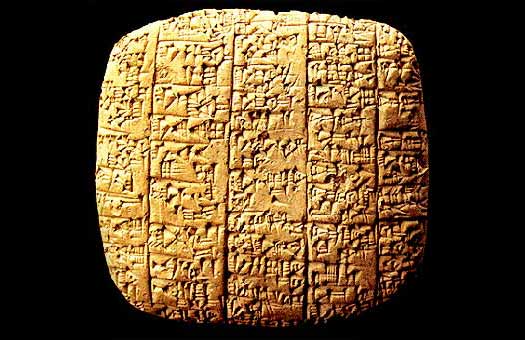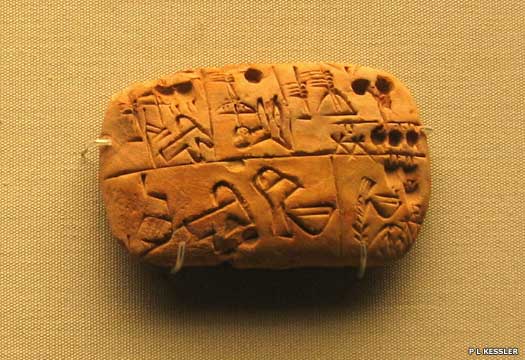
| CITY STATE OF MARI Mari was located in Mesopotamia (just inside the border of modern Syria) on the site of Tell Hariri on the west bank of the Euphrates - the most northerly of all the Sumerian city states. Thought to have been inhabited since the fifth millennium BC, the inhabitants of Mari were Semitic, probably part of the Eblaite and Akkadian migration. Their village became a flourishing city state from about 2900 BC until circa 1760 BC as a strategic stronghold between Sumer and the city states of Syria and northern Mesopotamia. It was destroyed in the 24th century BC and only revived when the Amorites succeeded the Sumerians. Hammurabi's Babylonian empire eventually conquered and sacked it in the eighteenth century BC.
FeatureThis is the tenth set of entries on the Sumerian list comprising kings 60-65. Six kings achieved dominance over Sumer, ruling for 136 / 184 years (Lists 1 & 2). Here, List 1 is primarily used, backed up by List 2 and List 3 (see Sumer for details). There are also further names which are not on the list (apart from Ilshu) and which seem to clash in their estimated dates. These are listed with a shaded background following Ilshu.
fl c.2600? BC :
Ninni-Zaza : God-king deified with a temple in his name, founded c.2600 BC.
Mari
holds the kingship from Adab, gaining ascendancy over areas of
northern Sumer (the dates do not fit in with those established
for Adab if the kingship is gained at the start of this dynasty,
so more probably the kingship is secured around 2350 BC, perhaps
only by Carrum-iter, with the list including his entire dynasty
to reflect his right to rule).

The surviving 17,000 or more clay tablets in the library of Ebla's Royal Archives are the earliest written documents in Syria, and they provide a wealth of detailed information about the region and its kingdoms and trade networks c.2500 - 2470 BC :
Ilshu / Anabu? / Anapu : Ruled for 30/90 years.
c.2470 - 2453 BC :
(Name unknown) / Anba : Son. Ruled for 17/7 years.
c.2470 - 2450 BC :
Lamgi-Mari
c.2453 - 2423 BC :
(Name unknown) / Bazi : Ruled for 30 years. The 'Leatherworker'.
c.2450 - 2445 BC :
Ikun-Shamash
c.2445 - 2425 BC :
Ikun-Shamagan
c.2440 - 2425 BC :
Mari is involved in frequent warfare against the dominant Lagash.
c.2425 - 2400 BC :
Iblul-Il
c.2400 BC :
Iblul-Il is credited with conquering the city state of Ebla.
c.2423 - 2403 BC :
(Name unknown) / Zizi : Ruled for 20 years. The 'Fuller'.
c.2403 - 2373 BC :
(Name unknown) / Limer : Ruled for 30 years. The 'Gudu Priest'.
c.2373 - 2364 BC :
(Name unknown) / Carrum-iter : Or Sharrum-Ite. Ruled for 9/7 years. Gained the kingship?
c.2364? BC :
The
king list records the kingship next passing briefly to the Third
Dynasty of Kish.
c.2334? BC :
Mari is destroyed, although opinion is divided on the culprit. It is likely either Sargon of Akkad (who later states that he passed through Mari on his campaign to the west, using it as a base of operations), or Mari's traditional commercial rivals, the people of Ebla. The region declines in importance with the city probably becoming little more than a village.
c.2260s? BC :
The
city is destroyed by Ebla, and a 'dynasty of generals' appears to
assume control.
Shakkanakku Rulers of Mari :
At around the same time as the city was again destroyed, this time by Ebla probably sometime around the 2260s BC, a 'dynasty of generals' (Akkadian shakkanakku) perhaps came into being as early as the reign of Manishtushu of Akkad. They ruled the city as an independent state which remained that way for the next 350 years. Their independence was probably prolonged by the Gutian invasion of Sumer. (The source for the list of generals is unknown, and the list itself is hardly ever reproduced elsewhere. Only the last name is not from the list, and appears in Ebla's records too.)
Ididish
Shudagan
Ishmedagan
Nûr-Mêr
c.2150 BC :
Ishtub'el
Ishgum'addu
Apîl'kîn
Iddin'el
Ilî'ishtar
Turâmdagan
Puzur'ishtar
c.2000 BC :
Hitlal'erra
Hanundagan
c.1950? BC :
Ibit-Lim : Last of dynasty of generals? Also controlled Ebla.
c.1900 BC :
The 'dynasty of generals' comes to an end, for reasons unknown, and Mari may even be abandoned. Either way, the Amorite peoples living in Terqa are able to move in and take over the region.
Amorite Rulers of Mari :
Some time before 2000 BC the population of Mari began to swell again as a result of the arrival of a confederation of tribes in Sumer called the Amorites. By 1900 BC the north-western Syrian Sim'alite branch of Amorites was already settled in nearby Terqa, about sixty kilometres to the north, and it now managed to subdue Mari (or repopulate it) and establish a relatively stable kingdom. Although records for it are sparse. a second age of prosperity began for the city. For a while it also manage to subdue the Hurrians of Urkesh.
c.1820 - 1811 BC :
Yaggid-Lim / Iagitlim : Amorite ruler, possibly from Terqa.
Mari and Ekallatum begin a feud that lasts until c.1761 BC.
c.1811 - 1795 BC :
Yahdun-Lim / Iadhun-Lim : Also king of Terqa? Assassinated by his servants.
Yahdun-Lim sends troops north towards the Mediterranean, to join those of Yamkhad in fighting against several previously subject Syrian tribal states, including Harran and Tuttul. The enemy armies are defeated and their towns are attacked. Given the fact that Shamshi-Adad soon conquers Mari and replaces its ruler, this would seem to be an attempt to fight back against him which ultimately fails. 
This
tablet from eighteenth century BC Mari contains records of food
supplies, with the symbol of a human head with a triangular object
in front of it being the verb 'to eat' in later Sumerian
c.1795 - 1791 BC :
Sumu-Yamam : Son. Also king of Terqa?
c.1791 BC :
Shamshi-Adad sets up an empire which stretches from the Mediterranean to the Zagros Mountains, the kingdom of Upper Mesopotamia. He conquers Mari, taking control of Terqa and Urkesh, and places Yasmah-Adad, one of his sons, on the throne. Yasmah-Adad marries Beltum, daughter of the king of Qatna, as his principal wife.
c.1791 - 1776 BC :
Yasmah-addu / Yasmah-Adad : Upper Mesopotamian 'Governor of Mari'. Overthrown.
c.1776 BC :
Upon the death of Shamshi-Adad, his kingdom falls apart. In Mari, the Amorite Zimri-Lim of Alakhtum and Terqa destroys Yasmah-Adad's forces. Yasmah-Adad himself is either killed or flees (sources fail to agree).
c.1776 - 1761 BC :
Zimri-Lim / Zimrilim : King of Mari, Alakhtum & Terqa.
Yahdun-Lim : Son. Predeceased his father.
Zimri-Lim greatly extends Mari's glory when he expands the royal palace to encompass more than 300 rooms, as well as founding the state archives. He establishes strong ties with Alep, Babylon and Hazor, having previously married Princess Shiptu, daughter of Sumu'epuh of Alep, and having been sold the city state of Alakhtum. He later marries the daughter of the king of Qatna, Dam-hurasim. He also establishes trade relations with at least thirty-two kings (mentioned in the palace archives), including those of Andarig and Apum, and counts Anum-Herwa of Zalwar as his vassal.
c.1761 BC :
Hammurabi turns on his old ally, defeating Zimri-Lim in battle and conquering Mari. Two years later Mari is sacked and devastated by Hammurabi and the region is incorporated into the Babylonian empire. The area is subsequently occupied by scattered groups of Assyrians and Babylonians, with the former city remaining a village. Power in the Middle Euphrates shifts some 100kms north to Zimri-Lim's home city of Terqa.
Kassite Rulers of Mari :
The Kassites were another non-Semitic, non-Indo-European mountain people just like the Amorites. They invaded Babylon in the eighteenth century BC and eventually conquered it, ruling over it until 748 BC. before then, they ruled locally in Mari, and perhaps in nearby Terqa too.
c.1730 - 1705 BC :
Gandash : Kassite leader when they invaded the Babylonian empire.
c.1730/15 BC :
The invading Kassite army under Gandash is crushed by Iluma-Ilum of the Sealand Dynasty. However, Gandash does successfully conquer Mari, and the Kassite kings reside there.
c.1705 - 1690 BC :
Agum I
c.1690 - 1680 BC :
Kashtiliash I : King of Terqa / Hana.
c.1680 - 1665 BC :
Ushshi
c.1665 - 1650 BC :
Abirattash
c.1650 - 1640 BC :
Kashtiliash II :
c.1640 - 1630 BC
Urzigurumash :
c.1630 - 1600 BC
Harbashihu :
c.1600 - 1595 BC
Tiptakzi
c.1595 BC :
Agum II : Conquered Babylon.
c.1595 BC :
The economically weakened Babylonian empire is sacked by the Hittites, allowing the Kassites to move south from Mari and take over control of Babylonia.
c.800s - 700s BC :
A dynasty of Assyrian governors leaves royal-style inscriptions without acknowledging the weakened Assyrian king. Instead, they cheekily claim descent from Hammurabi of Babylon.
c.331 BC :
The village of Mari disappears from history upon the arrival of the Greeks.
Source :
https://www.historyfiles.co.uk/ |